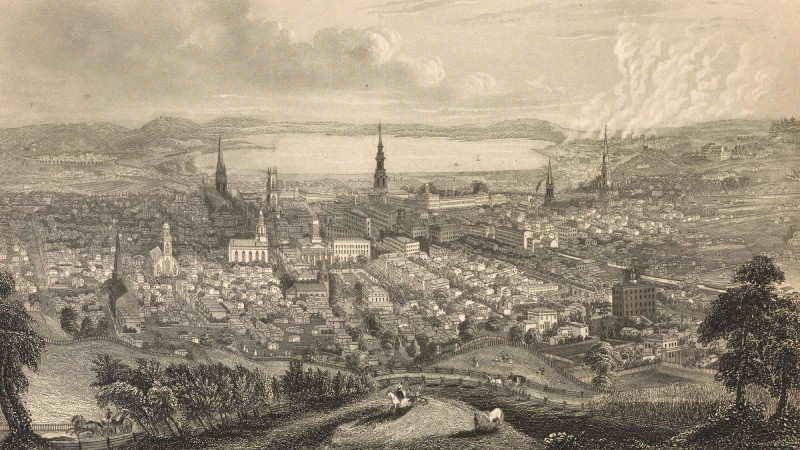
Historical Syracuse Etching circa 1800's
By Lee Smith
The Onondaga Citizens League was founded in 1978, issued its first report to the community in 1979, became a not-for-profit corporation in 1980, and was granted tax exempt status in 1981.
The organization resulted from programs conducted by Syracuse University’s Thursday Morning Roundtable (TMR). In 1976, members of this civic forum group traveled to Toronto, Canada for two days of meetings with Toronto officials on the subject of metropolitan government. The tour was co-sponsored by the Metropolitan Development Association, whose director, John Searles, was an active Roundtable member. Onondaga County Executive John Mulroy was present, as were many other well-known Roundtable members.
In Toronto, a presentation was given by Arthur Naftalin, a well-known official from Minneapolis. He described the long, successful experience of the Minneapolis-St. Paul Citizens League. That organization, the best known of several citizens leagues in the U.S., had been instrumental in much of the progress made by metropolitan government in the Twin City area.
Members of the Syracuse group were impressed with this example of citizen participation in public affairs. Upon returning to Syracuse, several Roundtable members, supported by county officials, mapped plans to develop a local version of the Minneapolis-St. Paul League. Assisted by several local planning groups, the Roundtable brought Arthur Naftalin to Syracuse for a series of meetings. This resulted in the development of a local organizing group of twenty members, mostly TMR members. By-laws were drawn and temporary officers were appointed. Lee Smith, director of TMR, became the first president.
After much discussion, the group adopted the title “Onondaga Citizens League.” Original Executive Board members included Carter Chase, Kate Hill, Leo Jivoff, Mary Korte, Minchin Lewis, James McDonald, Marilyn Pinsky, Roberta Schofield, John Searles, Lee Smith, Bill Thomas, Frank Woolever, and Helen Zych.
The early organizing efforts were aided by a “research intern” made available by a grant from the Onondaga County planning department. The intern, Richard Geisler, served as assistant to Lee Smith, arranging meetings and keeping members informed about the organizing progress.
Part of the rationale for organizing a citizens league was articulated by one of the founding group. Carter Chase was a prominent local attorney who was very active in community planning organizations. Early in 1977, responding to a proposal from Lee Smith, he wrote,
“Our community seems to need an organization or a process by which the support of the rank-and-file voter can be developed for proposals which do not sell themselves. Politicians and other decision makers seem to need clearly-expressed grounds for believing that if they take a proposed action they will have the support of a substantial majority of Onondaga County residents for not only the proposed action but for its necessary consequences such as increased taxes. A Citizen’s League could provide a tool to develop and express that support.”
Such thinking led to the choice of the first study topic for OCL: “What Would be the Impact of Full Value Property Assessment in Onondaga County and How Could We Prepare for Related Problems.”
Early promotion of OCL to increase membership included the following objective and procedure. “OCL is designed to encourage citizen education and involvement in public issues and problems. Its members discuss and find solutions to issues before they develop into real crises. The League does not promote specific legislation or function as a lobbying group. Each year, an OCL study committee selects a topic, which becomes the focus of presentations by numerous experts in that particular field. The topic is also researched and discussed by the study committee, which then issues a final report each year.”
The work of the League was administered by Assistant Dean Lee Smith’s office at University College of Syracuse University. This proved a most helpful support factor in the development of the organization. All office facilities were available as a University contribution, including space, telephone, mailing, duplication, and other services. Free, adjacent parking was also available for those attending meetings.
This service by SU proved invaluable during early organizing efforts for a citizens organization. The service has continued throughout the League’s history. In recent years, the League reimburses Syracuse University for direct, out-of-pocket expenses such as duplication and mailings. The League’s only employee was the individual who took notes during study committee meetings, prepared minutes, and wrote the drafts of committee reports. This person also prepared minutes of Board and other special meetings.
The League is governed by a Board of Directors, usually numbering about 25. Individuals are nominated at the annual meeting of OCL, usually in June, and six or seven members are elected each year for a three-year term. A director may serve two terms, or six years. The directors select their own officers- President, Vice President, Treasurer, and Secretary – who serve one-year terms, frequently re-elected for several terms. The Board of Directors meets once a month at the request of the President and Executive Vice President.
Each OCL study has been guided by one or several chairpersons, usually selected by the Executive Vice President and the Board of Directors. These individuals were very well-informed about the study topic and skillful in conducting discussion sessions. Before starting study committee sessions, the chairpersons met with several local resource people who were considered knowledgeable about some phase of the topic. This advisory committee helped to define the topic, create an outline for study committee meetings, and identify resource persons to address the study committee.
Studies usually began early in January, met each week for five or six months, and eventually resulted in a report to the community including specific recommendations regarding the problem studied. Committees, composed of volunteer members of OCL, usually met on a Wednesday at University College. Coffee or tea was provided and many participants brought lunch to the meetings. The commitment of chairpersons and committee members to this long and intensive study process accounts for the success and value of the Citizens League. In return, these volunteers learned a great deal about the topic and their community.
From the beginning, the work of the League, culminating each year in a lengthy report to the community, has received high praise from local media and interested groups and officials in the area. In 1980, the American College Testing Program and the National University Extension Association honored OCL for its first and second reports to the community. Governor Mario Cuomo cited the work of OCL several times, including the following: “The fact that a group of citizens has joined together to discuss public issues says something positive and unique about Onondaga County. There is no other group like OCL in the state, and very few across the nation. It shows that your county’s citizens are taking active steps to improve the community.”
Syracuse newspapers frequently praised the work of OCL citizen volunteers. Following the thirteenth report, an editorial claimed “The Onondaga Citizens League embodies all the best features of a participatory democracy . . . We know of no better vehicle for public-spirited citizens to have an impact on public policy.” In 1991, an editorial on a schools report headlined “Citizens League Report Rates an ‘A’.” The annual reports received glowing tributes from many officials and concerned organizations.
In a time characterized by lack of citizen knowledge, apathy, and political irresponsibility, the work of volunteers through the Citizens League is a refreshing story offering hope for the democratic process. Each of these studies required the time and thought of volunteers during the five or six months of weekly study sessions, usually 20-25 meetings.
Taken as a whole, these studies and resulting reports represent a large-scale effort at building community – citizens
getting involved, informed, and committed to improving the life of the community.
It is an exciting venture in making democracy work. There should be a Citizens League at work in many of our urban communities.
Anyone interested in the concept and the process can obtain information by calling University College at 315-443-4846 or E-mailing: ocl@syr.edu.
